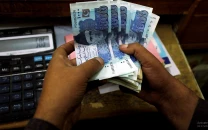Bad loans of banks increase to Rs457b

“In the backdrop of challenging economic environment, power shortages and security situation, increased credit risk remains a major challenge for the banking system,” said the report released by the SBP on Monday.
Asset quality of the banking system deteriorated over the quarter due to decline in advances and growth in NPLs. Lending portfolio came down mainly due to a decline in public sector commodity finance, it said.
The challenging economic environment both on domestic and external fronts and domestic security concerns resulted in low lending to small and medium enterprises and the consumer sector.
Farhan Rizvi, analyst at JS Global Capital Limited, said: “The quantum of NPLs, though still high, is falling gradually and this process is expected to continue in the near future. In view of low economic activities in the country, this phenomenon is not unexpected.”
Commercial bank lending to the public sector declined because of the unusual fall in public sector commodity finance, he added.
Lending to the public sector by commercial banks during January to March this year contracted substantially by 10.7 per cent while lending to the private sector increased by 0.2 per cent on top of a 4.16 per cent rise in the previous quarter. As a result, overall lending portfolio of the banking system declined by 2.4 per cent, the report said.
The report pointed out that equity base of the banking system remained almost at the last quarter level, however, due to increase in risk-weighted assets and decrease in eligible capital because of regulatory deductions, the risk-based Capital Adequacy Ratio (CAR) of the system dropped to 13.7 per cent (14.1 per cent in Dec-09), which is well above the minimum regulatory standard of 10 per cent.
“The stress test results showed that capital base of the system is strong enough to withstand unusual shocks in major risk factors,” the report said.
During the quarter under review, earnings of the banking system registered improvements, the report said, adding the sector posted an aggregate pre-tax profit of Rs29.1 billion (Rs26.2 billion in the Jan-Mar 2009 quarter) with return on assets (ROA) of 1.8 per cent (1.5 per cent for calendar year 2009).
Moreover, contrary to the recent trend of concentration of earnings in relatively large-sized banks, the quarter also witnessed an improvement in earnings of individual banks as the number of loss-making banks came down, the report added.
On the funding side, the deposit base of the system with slight contraction remained stable while 1.9 per cent growth in investments could not sustain the asset base which declined by 1.4 per cent, it said.
Published in the Express Tribune, June 8th, 2010.


1728020501-0/Express-Tribune-Web-(13)1728020501-0-208x130.webp)
















COMMENTS
Comments are moderated and generally will be posted if they are on-topic and not abusive.
For more information, please see our Comments FAQ